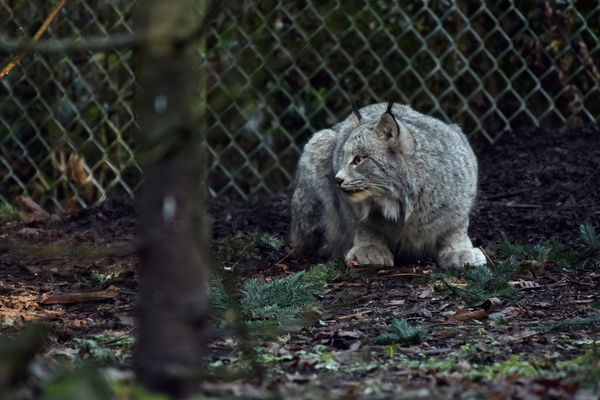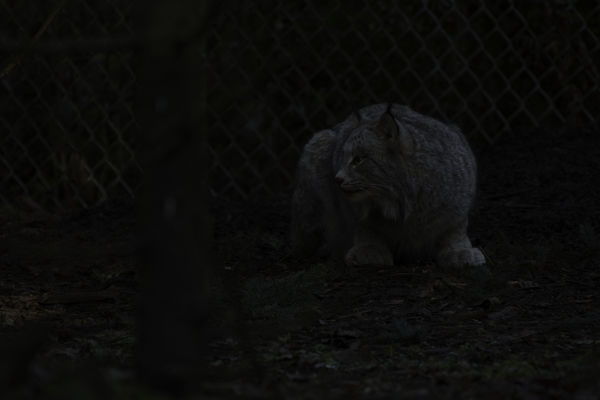ISO Invariance
Jan 31, 2017 13:50:49 #
Went to our favorite animal park in Western Washington State last Friday, a somewhat sunny day here. Saw the light was not bright as hoped, I set my D7200 initially to ISO 100, shutter 1/320 and with a fixed aperture of f5.6 on my 200-500, I went to work, I knew my shots would have to be under exposed to keep things sharp and clear.
This shot was taken at 500mm, f5.6, 1/160 (concerned that the exposure would be too dark) ISO 400 (again concerns over too-low an exposure that could not be recovered. Handheld. From a moving tram.
ISO Invariance and plentiful mp on the sensor allow this.
BTW: Set my wife's D3200 to shutter 1/320, Shutter priority (she used her beloved 55-300) and hoped the camera would make up the rest. She accidentally moved the selector to Program. The camera took some amazing shots from the moving tram. The camera selected ISOs in the 400 range. Shutter speeds of 1/20 to 1/60 were common as the lens dictated a min aperture f f4.5. VR worked pretty well but I should have checked her camera and reset it to Shutter priority.
This shot was taken at 500mm, f5.6, 1/160 (concerned that the exposure would be too dark) ISO 400 (again concerns over too-low an exposure that could not be recovered. Handheld. From a moving tram.
ISO Invariance and plentiful mp on the sensor allow this.
BTW: Set my wife's D3200 to shutter 1/320, Shutter priority (she used her beloved 55-300) and hoped the camera would make up the rest. She accidentally moved the selector to Program. The camera took some amazing shots from the moving tram. The camera selected ISOs in the 400 range. Shutter speeds of 1/20 to 1/60 were common as the lens dictated a min aperture f f4.5. VR worked pretty well but I should have checked her camera and reset it to Shutter priority.
Jan 31, 2017 14:13:09 #
Sinewsworn - Not exactly clear on the intent of your post. Are you asking UHH members why the second photo is underexposed? I assume the second photo was captured by your wife/'s camera which, as you note, was incorrectly set. What do you want us to do?
Jan 31, 2017 14:40:29 #
This something people on UHH "dance around" when discussing exposure.
Yes, it is great to get it all correct in camera, but as I detailed it is not always possible. So, I wish to open a discussion on this subject. That is, good images may be captured in less than ideal conditions and fixed in post.
Yes, it is great to get it all correct in camera, but as I detailed it is not always possible. So, I wish to open a discussion on this subject. That is, good images may be captured in less than ideal conditions and fixed in post.
Jan 31, 2017 15:12:36 #
Preaching to the choir with regard to myself. I would not argue with your last statement above. Good luck.
Jan 31, 2017 16:09:45 #
rjaywallace wrote:
Preaching to the choir with regard to myself. I would not argue with your last statement above. Good luck.

Jan 31, 2017 16:53:05 #
http://www.uglyhedgehog.com/t-427475-1.html#7183343
As noted at the beginning of that thread, there is nothing scientific on the experiment. Just some guy (me) learning the D500 limitations.
As long as folks are not really exposed to an invariant sensor there will be no in depth discussion. That is my experience anyway.
By the way, your 'correct exposure' when using an invariant sensor is not what it used to be, this technology is a game changer. If you take the time you will see in the same thread that I used ETTR with very similar results.
As noted at the beginning of that thread, there is nothing scientific on the experiment. Just some guy (me) learning the D500 limitations.
As long as folks are not really exposed to an invariant sensor there will be no in depth discussion. That is my experience anyway.
By the way, your 'correct exposure' when using an invariant sensor is not what it used to be, this technology is a game changer. If you take the time you will see in the same thread that I used ETTR with very similar results.
Feb 1, 2017 07:18:01 #
If all the articles were written like this, UH would be very uninteresting very fast. It is getting that way as it is
Feb 1, 2017 07:39:20 #
If the camera digitize the RAW file with sufficient number of bits then it's ISO invariance. Not so much on the sensor.
Feb 1, 2017 07:46:28 #
cthahn wrote:
If all the articles were written like this, UH would be very uninteresting very fast. It is getting that way as it is
I agree and this is not as bad as they come. What an embarrassment. If people write like that, imagine how they think. I will excuse those for whom English is not their native tongue.
But back to photography. As I read the original post, I interpret it to mean that he set the shutter, aperture and ISO without considering if the lightening matched these settings. Whether you like it or not, exposure is a compromise of settings so that the exposure matches the scene. If you want to use those settings, then you either have to add or subtract light. Why buy an expensive camera and then not use the meter to get the right exposure? I think the original poster has to go back to basics.
PS This post is like those that ask what exposure do I use to shoot such and such scene. Or will such and such lens work when I shoot whatever. They simply do not understand that no one knows until you are actually there. Again, back to basics.
Feb 1, 2017 07:57:26 #
Sinewsworn wrote:
...good images may be captured in less than ideal conditions and fixed in post.
Especially when shooting raw.
Feb 1, 2017 08:22:28 #
MJKilpatrick
Loc: Cape May, NJ
Hi rjaywallace, Please keep in mind there are no bad questions to be ask in any aspect of photography, or life in general. That being said, Sinewsworn does brings up a topic that may be related to your original question: Can good images may be captured in less than ideal conditions and fixed in post production? I would answer yes and the digital technology allows aspects of low light treatment that play out to achieving a good image in less than ideal conditions. Since I am mostly a wildlife photographer, birds more specifically, and live in a coastal area, the skies do not always afford that open or bright light yet some of the best opportunities are presented in overcast and low light weather. There is a balance of ISO, shutter speed and depth that is needed and often one of these elements, sometimes two, suffer in low light. One technique is under exposure. As long as your abilities stay inside a range of capture that allows retention of detail, post production work can correct. In my case, I always shoot on manual and cannot remember a time I used program or an auto setting. If I have low, dull light, I can underexpose up to three stops of light and still bring the photo to a well balanced end by correcting exposure, contrast and color in post production. Most software programs have these three adjustments available. So I often will elect underexposure to maintain a minimum shutter speed or keep the ISO and noise in check and then adjust the photo in post production. It has its range of limitations, something with no detail is not often corrected, but within a two to three stop difference, the detail is usually there and the photo can be adjusted as long as your darker areas of the photo retain detail. It does not work as well overexposing, or at least in my case, as details in white or lighter areas do not seem to retain detail as well when overexposed as darker areas do underexposed. I have brought many photos home like your second photo and adjusted to look like your first photo although your second photo, for me, is right on the edge of the underexposed limit. But underexposure is something I elect do in the field often under low and dull light conditions to retain needed shutter speed or ISO levels.
Feb 1, 2017 11:56:00 #
many wrote:
.../...
Do you even understand what invariant means and what is the difference from the other 'normal (variant)'?
Variant: The sensor is driven by how much power (voltage) is applied to it.
Invariant: The sensor has a nominal power applied to it and that never changes. What changes is the in camera software process that can be (better) duplicated in post processing.
Which in turns means a variant sensor is limited to 'correct exposure'* when the invariant sensor is limited by the person doing the Post processing. This is turns makes the use of ISO questionable in the long term. It does not overrides other needs like composition and correct settings adapted to the subject being captured (Focus, Aperture and speed. Forget WB because this a raw 'affair')
-----
* Includes various exposure techniques like ETTR, EBTR and UniWB.
Feb 1, 2017 15:46:42 #
Rongnongno wrote:
Do you even understand what invariant means and what is the difference from the other 'normal (variant)'?
Variant: The sensor is driven by how much power (voltage) is applied to it.
Invariant: The sensor has a nominal power applied to it and that never changes. ...
Variant: The sensor is driven by how much power (voltage) is applied to it.
Invariant: The sensor has a nominal power applied to it and that never changes. ...
It's pretty clear from that statement that you have no clue about the nature of the difference. Just Google 'variant vs invariant sensor'.
You can start with ISO Variance. There is no mention of power or voltage which are, of course, not the same thing.
Feb 1, 2017 16:08:19 #
selmslie wrote:
.../...
As usual the moron comes along...
Raise the voltage = raise power. Why? P=UI.
Stupid ****
Feb 1, 2017 16:51:05 #
Rongnongno wrote:
As usual the moron comes along...
Raise the voltage = raise power. Why? P=UI.
Stupid ****
Raise the voltage = raise power. Why? P=UI.
Stupid ****
The formula for power is P=(I^2)*R or P=(V^2)/R. If you assume V and U are both voltage you can replace one with the other so that U=RI is the same as V=RI. But all you are doing is displaying different forms of Ohm's law and the relationship between voltage, resistance, current and power. We learned that in 5th grade General Science. It's not rocket science.
And neither one gets applied to the sensor. It would erase the charge that was recorded on the sensor by the number of photons that struck it. You cannot count photons without destroying them. You might also take a look into Heisenberg's uncertainty principle to see why.
What you do with the sensor is to read the charge from the sensor and convert that to a numeric value to place into the raw file. The value that ends up in the raw file depends, not only on the number of photons received by the sensor, but on the precision of the read operation and the calculations applied by the program doing the work.
I suggest you stick to subjects that you do understand. This is not one of them. You are in over your head. Calling people names does not make you any smarter.
If you want to reply, then register here. Registration is free and your account is created instantly, so you can post right away.







